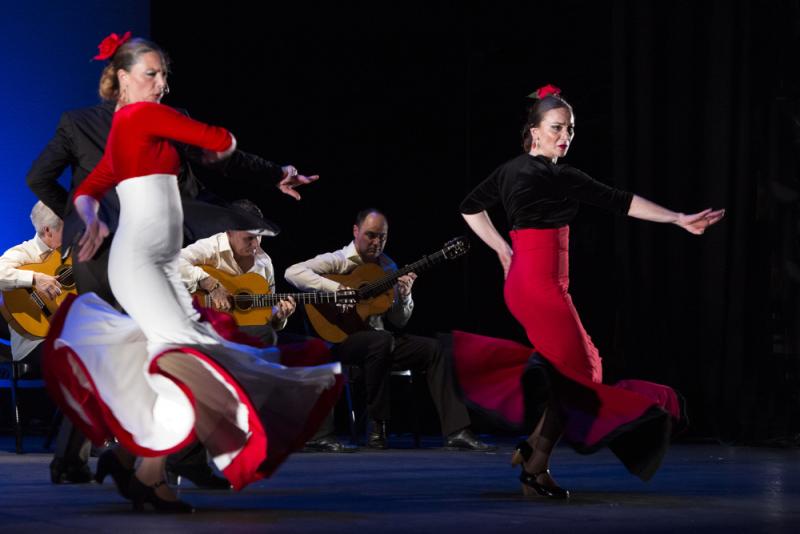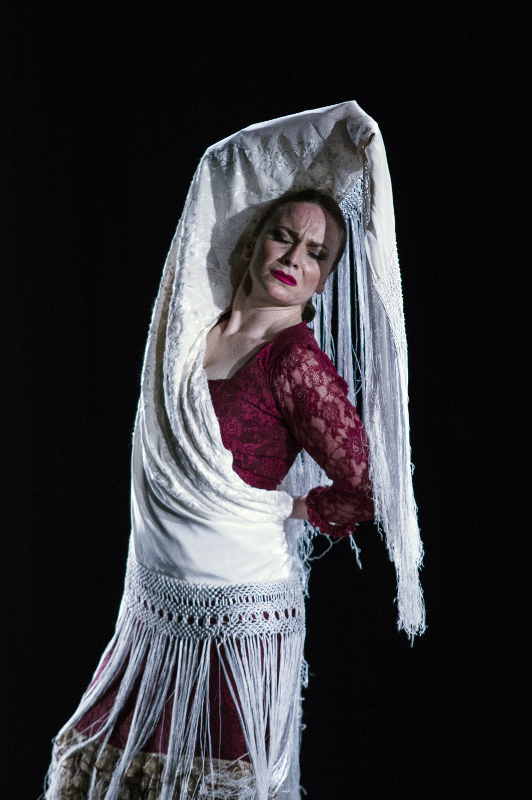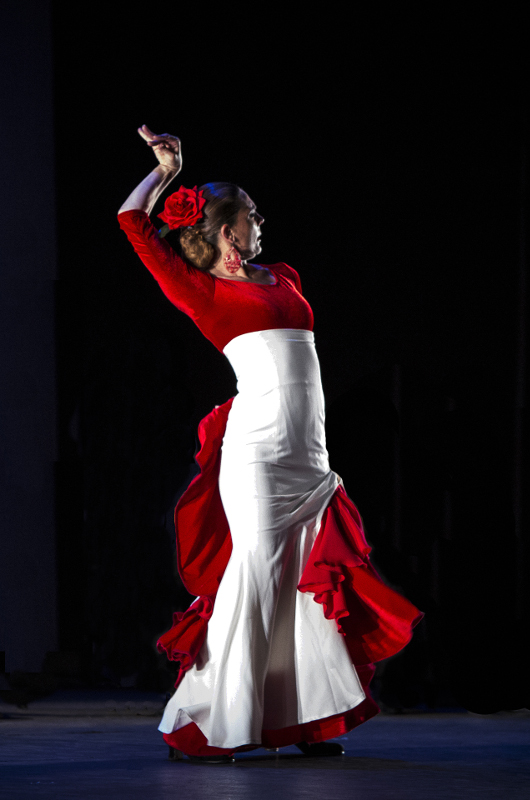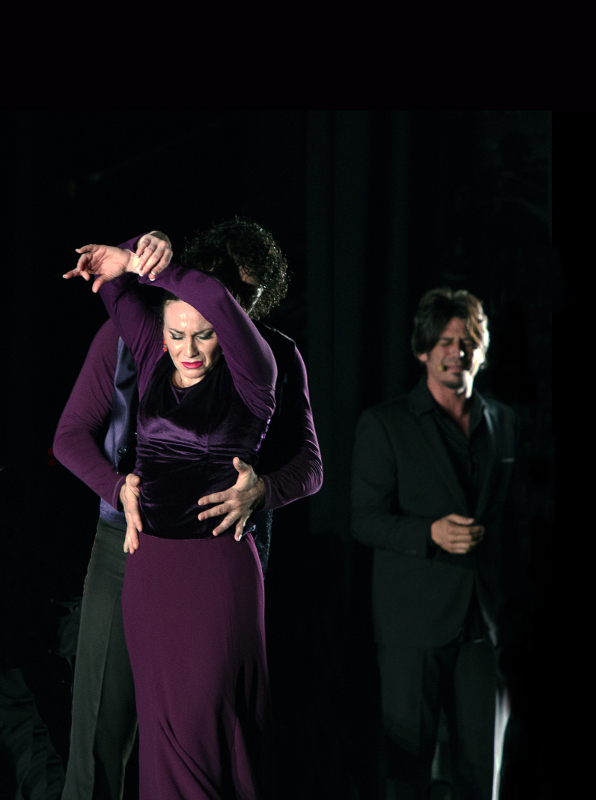Flamencura, Paco Peña Company, Sadler's Wells | reviews, news & interviews
Flamencura, Paco Peña Company, Sadler's Wells
Flamencura, Paco Peña Company, Sadler's Wells
Top-quality showcase from some of the best in the business

No, don't check your calendar – it's definitely not March. I associate flamenco at Sadler's Wells so strongly with their annual two-week festival in early spring that watching Paco Peña Company at the Wells last night felt a bit like a cheeky out-of-season treat, akin to buying foreign strawberries before the native ones have come in.
The new show, Flamencura, does not follow Peña's last, Garcia Lorca-themed piece, Patrias, down the route of conceptual unity and quasi-narrative. Flamencura is "just" a flamenco showcase – but what a one! The ten episodes that make it up offer a richly rounded menu of the art form's possibilities, from haunting solo guitar work to sensual danced pas de deux, from ebullient Andalusian castanets to silken Granadan shawls, from festival fandangos to searing songs evoking flamenco's origins among the poor and disposessed. This latter element also allows Peña to introduce flamenco's relationship to other vernacular musical traditions by using young British jazz/soul vocalist Vimala Rowe, who graces a segment titled "Martinete", intended to suggest the protest of workers in the forges.
 Peña's own guitar playing is one of the highlights of any show, and here he treats us to a wistful bluesy solo inspired by the Andalusian city of Ronda; though his virtuosic technique is dazzling (playing a melody on the lower strings at the same time as a fast, bubbling ostinato on the high strings), it's his construction of mood that reveals the true master, in a wordless song that many times approaches sweetness before melting back into a quizzical melancholy – like a dark rainy day punctuated by bursts of watery golden sunshine.
Peña's own guitar playing is one of the highlights of any show, and here he treats us to a wistful bluesy solo inspired by the Andalusian city of Ronda; though his virtuosic technique is dazzling (playing a melody on the lower strings at the same time as a fast, bubbling ostinato on the high strings), it's his construction of mood that reveals the true master, in a wordless song that many times approaches sweetness before melting back into a quizzical melancholy – like a dark rainy day punctuated by bursts of watery golden sunshine.
The three dancers in the company have different strengths and different moods. Carmen "La Talegona" has the gravitas you might expect of a woman who has an epithet instead of a surname: she's one of those splendidly powerful middle-aged women who make flamenco such a refreshing dance form to watch, all ample hips and adamantine stare. Her Andalusian-style soleá with castanets is tremendous: passionate, at times intensely fast, and imbued with a kind of proud endurance laced with anger, a woman who knows her worth and takes no shit. Her softer side comes on view later, when she does one of those Granadan-style dances with fringed shawl (pictured above right), which always fascinate me because of their ability to turn fabric into an emotional extension of skin or flesh.
 Charo Espino (pictured left) is of a slighter build and far more the thoroughbred; in her second solo she sashays on in a tight blue skirt and mustard yellow blouse that could practically be a J Crew get-up for an American first lady, were it not for the skirt's large ruffled hem, a restrained gesture towards a bata de colaya. Spine arched, shoulders back and nose in the air, smiling a wolfish smile that doesn't reach as far as her frowning eyes until the very end, she dominates the stage and mixes fast and slow steps – and even a bit of archly provocative bum-wiggling! – with aristocratic composure. In the opening of the final fandango she exhibits the same queenly stage presence, imbuing those characteristic flamenco twists of hand and wrist with such a weight of tradition and refinement that one feels any attempt to imitate the same – apparently simple – movements would be doomed, destined only for miserable vacuousness.
Charo Espino (pictured left) is of a slighter build and far more the thoroughbred; in her second solo she sashays on in a tight blue skirt and mustard yellow blouse that could practically be a J Crew get-up for an American first lady, were it not for the skirt's large ruffled hem, a restrained gesture towards a bata de colaya. Spine arched, shoulders back and nose in the air, smiling a wolfish smile that doesn't reach as far as her frowning eyes until the very end, she dominates the stage and mixes fast and slow steps – and even a bit of archly provocative bum-wiggling! – with aristocratic composure. In the opening of the final fandango she exhibits the same queenly stage presence, imbuing those characteristic flamenco twists of hand and wrist with such a weight of tradition and refinement that one feels any attempt to imitate the same – apparently simple – movements would be doomed, destined only for miserable vacuousness.
Though eminently capable of delivering thrills through traditional methods like blisteringly fast footwork, tall Angel Muñoz makes more obvious homage to contemporary dance in some of his choreography – his major solo sees him executing snappy slides across the stage like a Brylcreemed refugee from West Side Story, for instance, while the opening of his duet with La Talegona seems to reference the sexy, leggy chair dancing Bob Fosse choreographed for Liza Minelli.
 This piece is the standout of the show, though perhaps not for the right reasons: while Muñoz's mixture of feminine sensuality with a more obviously masculine anger is compelling, and his pas de deux work with La Talegona outstanding (flamenco is sexy less often than you might think, but their hands on hips business here, pictured right, is the real deal), the use of a black veil and the apparent strangling that close it are troubling. You can't help but see echoes of ISIS murdering hostages, but without knowing the words of the song – the usual problem in flamenco – we remain in the dark.
This piece is the standout of the show, though perhaps not for the right reasons: while Muñoz's mixture of feminine sensuality with a more obviously masculine anger is compelling, and his pas de deux work with La Talegona outstanding (flamenco is sexy less often than you might think, but their hands on hips business here, pictured right, is the real deal), the use of a black veil and the apparent strangling that close it are troubling. You can't help but see echoes of ISIS murdering hostages, but without knowing the words of the song – the usual problem in flamenco – we remain in the dark.
Vimala Rowe is a valuable addition to the line-up of flamenco artists not only for her wonderful voice, but because – in "Martinete" at least – she sings in English, and so conveys, through her bluesy lyrics, what it must be like to understand flamenco songs, which are often searing poems about loss, anger, or simply a bittersweet moment in time. With the very dark lighting and black costumes used in this piece, the dancers – executing a more contemporary staggered sequence of movements – take second place to the splendid Rowe's visceral, physical singing.
Early in the performance, I wondered if I was enjoying Flamencura so much because it had been months since I last saw flamenco, or if it was simply because Paco Peña Company are so satsifyingly good at what they do. The truth may be a mixture of both, but I would certainly defy anyone not to take delight in this extremely well-constructed, well-performed showcase of a magnificent art form.
- Flamencura is at Sadler's Wells until 28 June.
rating
Explore topics
Share this article
The future of Arts Journalism
You can stop theartsdesk.com closing!
We urgently need financing to survive. Our fundraising drive has thus far raised £49,000 but we need to reach £100,000 or we will be forced to close. Please contribute here: https://gofund.me/c3f6033d
And if you can forward this information to anyone who might assist, we’d be grateful.

Subscribe to theartsdesk.com
Thank you for continuing to read our work on theartsdesk.com. For unlimited access to every article in its entirety, including our archive of more than 15,000 pieces, we're asking for £5 per month or £40 per year. We feel it's a very good deal, and hope you do too.
To take a subscription now simply click here.
And if you're looking for that extra gift for a friend or family member, why not treat them to a theartsdesk.com gift subscription?
more Dance
 'We are bowled over!' Thank you for your messages of love and support
Much-appreciated words of commendation from readers and the cultural community
'We are bowled over!' Thank you for your messages of love and support
Much-appreciated words of commendation from readers and the cultural community
 R:Evolution, English National Ballet, Sadler's Wells review - a vibrant survey of ballet in four acts
ENB set the bar high with this mixed bill, but they meet its challenges thrillingly
R:Evolution, English National Ballet, Sadler's Wells review - a vibrant survey of ballet in four acts
ENB set the bar high with this mixed bill, but they meet its challenges thrillingly
 Like Water for Chocolate, Royal Ballet review - splendid dancing and sets, but there's too much plot
Christopher Wheeldon's version looks great but is too muddling to connect with fully
Like Water for Chocolate, Royal Ballet review - splendid dancing and sets, but there's too much plot
Christopher Wheeldon's version looks great but is too muddling to connect with fully
 iD-Reloaded, Cirque Éloize, Marlowe Theatre, Canterbury review - attitude, energy and invention
A riotous blend of urban dance music, hip hop and contemporary circus
iD-Reloaded, Cirque Éloize, Marlowe Theatre, Canterbury review - attitude, energy and invention
A riotous blend of urban dance music, hip hop and contemporary circus
 How to be a Dancer in 72,000 Easy Lessons, Teaċ Daṁsa review - a riveting account of a life in dance
Michael Keegan-Dolan's unique hybrid of physical theatre and comic monologue
How to be a Dancer in 72,000 Easy Lessons, Teaċ Daṁsa review - a riveting account of a life in dance
Michael Keegan-Dolan's unique hybrid of physical theatre and comic monologue
 A Single Man, Linbury Theatre review - an anatomy of melancholy, with breaks in the clouds
Ed Watson and Jonathan Goddard are extraordinary in Jonathan Watkins' dance theatre adaptation of Isherwood's novel
A Single Man, Linbury Theatre review - an anatomy of melancholy, with breaks in the clouds
Ed Watson and Jonathan Goddard are extraordinary in Jonathan Watkins' dance theatre adaptation of Isherwood's novel
 Peaky Blinders: The Redemption of Thomas Shelby, Rambert, Sadler's Wells review - exciting dancing, if you can see it
Six TV series reduced to 100 minutes' dance time doesn't quite compute
Peaky Blinders: The Redemption of Thomas Shelby, Rambert, Sadler's Wells review - exciting dancing, if you can see it
Six TV series reduced to 100 minutes' dance time doesn't quite compute
 Giselle, National Ballet of Japan review - return of a classic, refreshed and impeccably danced
First visit by Miyako Yoshida's company leaves you wanting more
Giselle, National Ballet of Japan review - return of a classic, refreshed and impeccably danced
First visit by Miyako Yoshida's company leaves you wanting more
 Quadrophenia, Sadler's Wells review - missed opportunity to give new stage life to a Who classic
The brilliant cast need a tighter score and a stronger narrative
Quadrophenia, Sadler's Wells review - missed opportunity to give new stage life to a Who classic
The brilliant cast need a tighter score and a stronger narrative
 The Midnight Bell, Sadler's Wells review - a first reprise for one of Matthew Bourne's most compelling shows to date
The after-hours lives of the sad and lonely are drawn with compassion, originality and skill
The Midnight Bell, Sadler's Wells review - a first reprise for one of Matthew Bourne's most compelling shows to date
The after-hours lives of the sad and lonely are drawn with compassion, originality and skill
 Ballet to Broadway: Wheeldon Works, Royal Ballet review - the impressive range and reach of Christopher Wheeldon's craft
The title says it: as dancemaker, as creative magnet, the man clearly works his socks off
Ballet to Broadway: Wheeldon Works, Royal Ballet review - the impressive range and reach of Christopher Wheeldon's craft
The title says it: as dancemaker, as creative magnet, the man clearly works his socks off
 The Forsythe Programme, English National Ballet review - brains, beauty and bravura
Once again the veteran choreographer and maverick William Forsythe raises ENB's game
The Forsythe Programme, English National Ballet review - brains, beauty and bravura
Once again the veteran choreographer and maverick William Forsythe raises ENB's game

Add comment